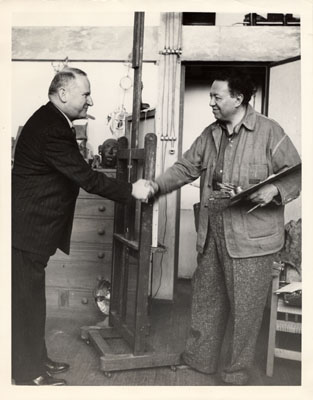Timothy Pflueger

Architect Timothy Pflueger was the son of German immigrants who came to San Francisco in the late 1880s. Born in 1892, he grew up in the working class Mission District. He began his career as an architectural draftsman while many in the city rallied to rebuild San Francisco after the devastation of the earthquake and fire of 1906.
Through his early office training with J.R. Miller, who later became his partner, and in classes at the San Francisco Architectural Club, Pflueger was steeped in the Beaux Arts style popular after the turn of the century. He eventually sought more exotic influences beyond Europe’s academic teachings for modern expressions of the fast-moving Jazz Age, and later more streamlined forms during the Great Depression.
He designed some of the city's best-loved neighborhood movie theatres, the Castro Theatre and the Paramount Theatre in Oakland, skyscrapers including the Pacific Telephone Building, the Mayan splendor of 450 Sutter and the San Francisco Stock Exchange tower and luncheon club. During the Great Depression, public school projects, such as George Washington High School and stunning cocktail lounges like the Top of the Mark were among the firm's work. Pflueger also was chairman of the board of architects of the Bay Bridge and on the committee of architects who designed the 1939-1940 World's Fair at Treasure Island. Pflueger's Federal Building was among the most modern buildings at the fair. He also came up with the idea for "Art in Action," where muralist Diego Rivera was the star attraction, working amid other well-known local artists, forming an exhibit on the making of art at the fair.

During the "Art in Action" exhibit, Diego Rivera painted an an extraordinary work of Pan American art and an inspiring vision of Pan-American Unity. His grand, 22' high and 74' long, mural, is entitled “Unión de la Expresión Artistica del Norte y Sur de este Continente” (The Marriage of the Artistic Expression of the North and of the South on this Continent). It is a sweeping synthesis of the art, religion, history, politics, and technology of the Americas that is as timely now as it was sixty years ago. Commonly referred to as the "Pan American Unity", the artwork features Diego Rivera, Frida Khalo, Timothy Pflueger and the 450 Sutter Building within the mural
Pflueger was also the president of the San Francisco Art Association for several years and was a founding director of the museum now known as San Franisco Museum of Moderm Art (SFMOMA). In the late 1930s and through the 1940s, he also designed several I. Magnin stores for Grover Magnin, including the white marble lady that remains a focal point of Union Square today.
The SFMOMA has an exhibit dedicated to J.R. Miller & T.L. Pflueger, some of which can be viewed online here.
For more information about Timothy Pflueger, we highly recommend reading Art Deco San Francisco: The Architecture of Timothy Pflueger by Therese Poletti. You can find out more about the book and Timothy Pflueger's work here: http://timothypflueger.com.

